Free printable geometric measurement worksheets for 3rd Grade math practice
Are you looking for fun and engaging ways to help your 3rd graders practice geometric measurement skills? Do you want to save time and money using free printable worksheets aligned with the Common Core standards? If so, you are in the right place!
-
This article will share a remarkable collection of free printable geometric measurement worksheets for 3rd Grade math practice. These worksheets cover area, perimeter, angles, and shapes. They are perfect for homework, review, or enrichment activities.
Why geometric measurement is important for 3rd Graders
There are many reasons why Geometric measurement is an important skill for 3rd graders to master. First, it helps them understand the properties of shapes and how they relate to each other. Secondly, it prepares them for more advanced topics in geometry and algebra.
This article will give you an overview of outstanding geometric measurement worksheets and how to use them to help your child or students practice and improve their math skills.
In line with this, we’ll introduce you to Mathskills4kids.com, an educational math website covering all math concepts, including geometric measurement, according to the Common Core standards.
This website has objectives for 3rd graders to acquire the following geometric measurement skills before moving on to the next Grade. These skills include:
- Recognize and measure the area and perimeter of plane figures using standard units of measure.
- Understand that rectangles can be decomposed into two congruent right triangles.
- Understand that the area of a rectangle is equal to the product of its length and width.
- Understand that the perimeter of a polygon is equal to the sum of the lengths of its sides.
- Understand that shapes in different categories may share attributes and that the shared attributes can define a larger category.
- Identify and classify quadrilaterals based on their properties, such as parallel and perpendicular sides, angles, and symmetry.
- Recognize and draw shapes having specified attributes, such as a given number of angles or a given number of equal faces.
- Partition shapes into parts with equal areas and express the area of each part as a unit fraction of the whole.
These skills are important for math and other subjects such as science, art, and engineering. They help students understand the world around them and create beautiful designs and structures.
-
BROWSE THE WEBSITE
-
DOWNLOAD FREE WORKSHEETS
-
-
3rd GRADE MATH TOPICS
- Number and compapring
- Place value
- Addition
- Subtraction
- Understand multiplication
- Multiplication skill builders
- Multiplication fluency
- Multiplication
- Understand division
- Division skill builders
- Division fluency
- Division practice
- Mixed operation
- Properties
- Equations & variations
- Estimate & rounding
- Logical reasoning
- Patterns
- Money
- Telling time
- Data graph & probability
- Understanding fractions
- Equivalent fractions
- Comparing and ordering fractions
- Operations with fractions
- Unit of measurement
- Two-dimensional shapes
- Triangles and quadrilaterals
- 3D shapes
- Geometric measurement
-
-
Finding the missing side length given perimeter
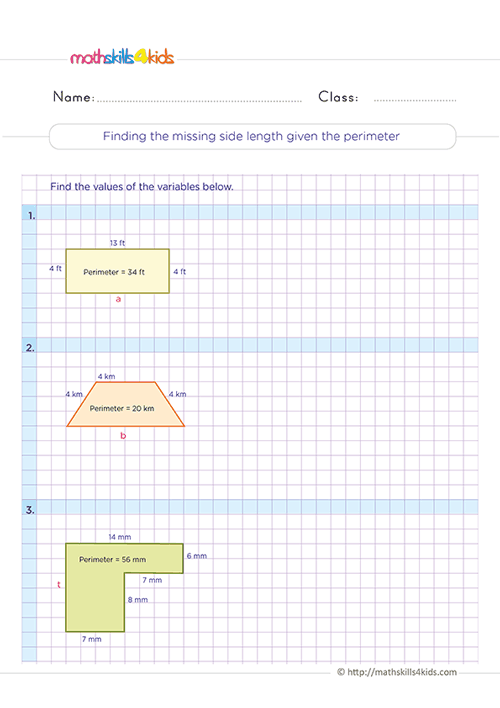 Print it...
Print it...
-
Selecting two figures with the same area
 Print it...
Print it...
-
how to create figures with a given area
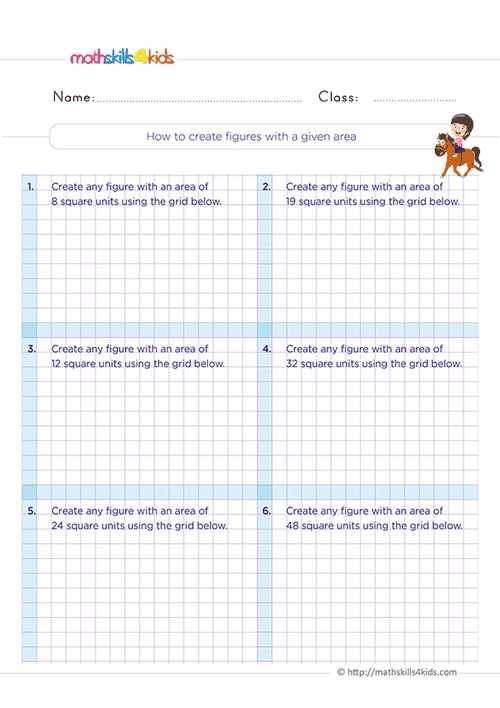 Print it...
Print it...
-
How to find the area of rectangles and squares
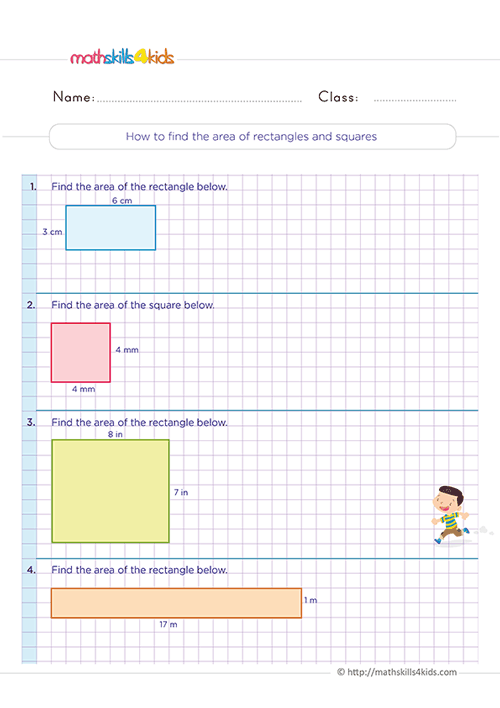 Print it...
Print it...
-
How to find the area of rectangles with missing unit squares
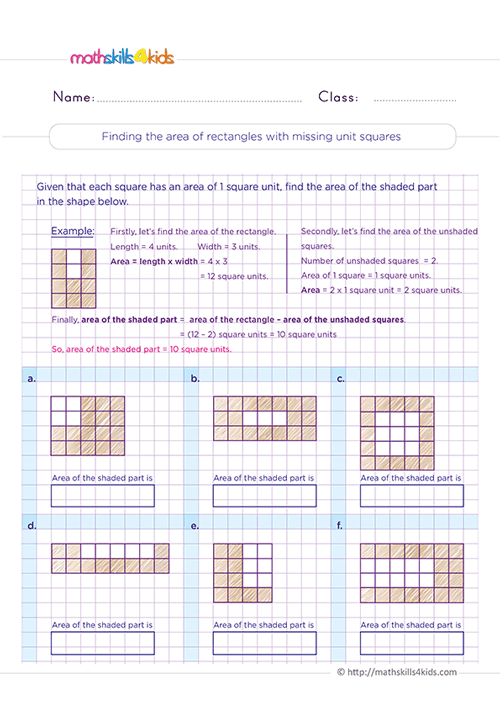 Print it...
Print it...
-
Solving area of a rectangle word problems
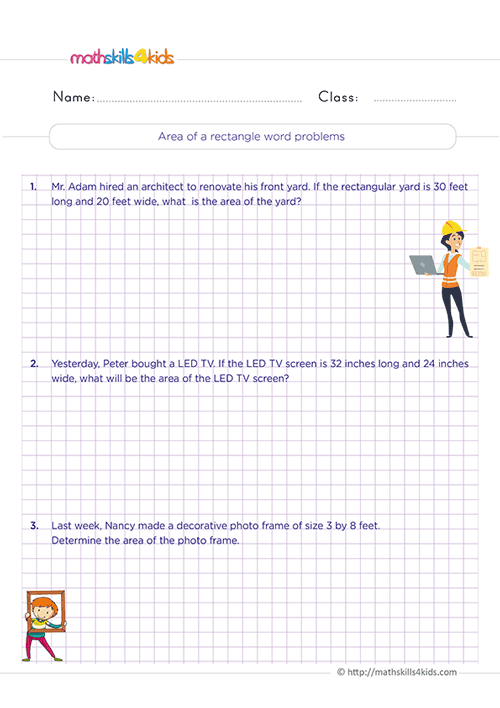 Print it...
Print it...
-
Finding the missing side length given perimeter
-
Buying is supporting us!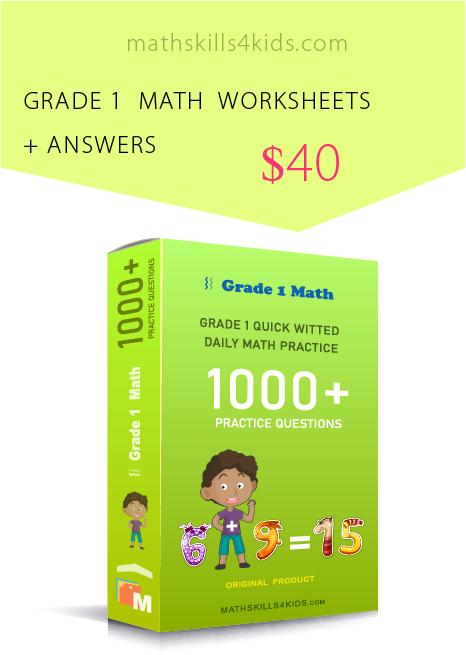
Buy Now...
-
-
Some examples of MathSkills4Kids free printable geometric measurement worksheets for 3rd-grade math practice
There are many skills that 3rd graders need to learn regarding geometric measurement. Some of the most important ones you’ll find in MathSkills4Kids free printable geometric measurement worksheets for 3rd-grade math practice are:
- Finding the perimeter of rectangles and squares: The perimeter is the distance around a shape. To find the perimeter of a rectangle or a square, you need to add the lengths of all the sides.
- How to find the perimeter of rectilinear shapes: Rectilinear shapes are made of rectangles. To find the perimeter of a rectilinear shape, you need to add up the lengths of all the outer sides.
- How to find the perimeter of polygons: Polygons are shapes with three or more sides. To find the perimeter of a polygon, you need to add up the lengths of all the sides.
- Finding the missing side length given the perimeter: Sometimes, you may know the perimeter of a shape but not one of the side lengths. To find the missing side length, subtract the known side lengths from the perimeter and divide by the number of missing sides.
- How to find the areas of figures made of unit squares: Unit squares are squares that have a side length of one unit. To find the area of a figure made of unit squares, count how many unit squares fit inside the figure.
- How to tile a rectangle and find the area: Tiling a rectangle means covering it with smaller rectangles or squares without gaps or overlaps. To find the area of a tiled rectangle, you need to multiply the length and width of one tile by the number of tiles in each row and column.
- How to create figures with a given area: Sometimes, you may want to create a figure with a certain area. To do this, consider different ways to arrange unit squares or tiles into a shape with the desired area.
- How to find the area of rectangles and squares: The area is the space inside a shape. To find the area of a rectangle or a square, you need to multiply the length and width of the shape.
- Find the areas of complex figures using unit squares: Complex figures are made of two or more shapes. To find the area of a complex figure, you need to break it down into smaller shapes that are easier to measure, such as rectangles, squares, triangles, or circles. Then, you need to find the area of each smaller shape and add them up.
-
How to use free printable worksheets to practice geometric measurement skills
One of the best ways to practice geometric measurement skills is using free printable worksheets. Here are some steps on how to use them effectively:
- Download and print the worksheets: You can find many free printable worksheets that cover different geometric measurement skills online. You can choose from different difficulty levels and formats, such as multiple choice, fill-in-the-blanks, word problems, or puzzles.
- Choose the appropriate skills: Depending on your child or student's needs and goals, you can select which skills they need to work on. You can also mix and match different skills in one worksheet or use different worksheets for different skills.
- Follow the instructions and solve the problems: Each worksheet will have clear instructions on what to do and how to solve the problems. Make sure your child or student reads and understands them before starting. Then, they can use their knowledge and strategies to find the answers.
- Check answers and review mistakes: After completing a worksheet, it is important to check if the answers are correct and review any mistakes. You can use an answer key or a calculator to verify the answers. You can also explain why an answer is right or wrong and how to avoid making similar errors in the future.
-
Why geometric measurement worksheets are a great resource for teachers and parents
Geometric measurement worksheets are useful for practicing math skills and are a great resource for teachers and parents. Some of the benefits they provide are:
- They are free and printable: You don't have to spend money or time buying or making your worksheets. You can download and print them whenever you need them.
- They are available for different skills and levels: You can find worksheets that cover all the geometric measurement skills that 3rd graders need to learn. You can also find worksheets that suit different levels of ability and challenge, from easy to hard.
- They are flexible and adaptable: You can use worksheets for different purposes and occasions, such as homework, classwork, assessment, review, or enrichment. You can modify or customize them to fit your child’s or student's preferences and needs.
-
Creative ways to use geometric measurement worksheets in your classroom or at home
Much more than free printable geometric measurement worksheets for 3rd Grade math practice is required to enhance 3rd graders' geometric measurement skills. You can also use creative and fun ways to make learning geometric measurements in your classroom and home more engaging and enjoyable.
Here are some ideas that you can use:
- Group activities: You can divide your child or students into small groups and give them a worksheet to work on together. They can discuss problems, share ideas, and help each other. You can also make it a competition and see which group can finish the worksheet first or get the correct answers.
- Interactive games: You can turn a worksheet into a game by adding some elements of fun and excitement. For example, you can use dice, cards, spinners, or timers to determine which problem to solve or how much time to spend on it. You can also use rewards, such as points, stickers, or prizes, to motivate your child or students.
- Real-life applications: You can connect geometric measurement skills to real-life situations and problems your child or students can relate to. For example, you can ask them to measure the perimeter or area of objects in their surroundings, such as furniture, books, or toys. You can also ask them to create shapes with a given perimeter or area using materials such as paper, string, or blocks.
-
How geometric measurement worksheets can help your child succeed in math
Constant practice of geometric measurement worksheets can help your child succeed in math. This is because geometric measurement skills with worksheets can positively impact your child or student's math performance and achievement.
Some of the ways that worksheets can help are:
- Improved spatial reasoning and problem-solving skills: Spatial reasoning is the ability to visualize and manipulate shapes and objects in space. Problem-solving is the ability to find solutions to challenging situations or questions.
Geometric measurement worksheets can help your child or student develop these skills by requiring them to think critically and creatively about shapes, measurements, and relationships.
- Increased understanding of mathematical concepts: Geometric measurement worksheets can help your child or student understand the concepts behind the formulas and procedures they use. They can also help them see the connections between different topics in math, such as geometry, algebra, fractions, and decimals.
- Enhanced confidence and interest in math: Geometric measurement worksheets can help your child or student feel more confident and interested in math by providing opportunities to practice and improve their skills. They can also help them see math as fun and rewarding by offering them variety and challenges.
- Improved spatial reasoning and problem-solving skills: Spatial reasoning is the ability to visualize and manipulate shapes and objects in space. Problem-solving is the ability to find solutions to challenging situations or questions.
Bonus: Find more resources to reinforce third-grade geometric measurement learning here!
If you want to give your 3rd graders more practice and fun with geometric measurement, you can check out these amazing resources that we have found online.
They are all free to download and print. Also, they include answer keys and instructions.
- Geometric Measurement Bingo: This is a fun game you can play with your whole class or small groups. It reviews concepts such as area, perimeter, angles, and shapes. You can find it here: https://www.teacherspayteachers.com/Browse/Search:geometry%20bingo
- Geometric Measurement Task Cards: These are 24 cards that you can use for centers, scoot, or independent work. They have different questions requiring students to apply their geometric measurement skills. You can find them here: https://the-teacher-next-door.com/product/3rd-grade-geometric-shapes-task-cards-geometric-shapes-center-geometry-game/
- Geometric Measurement Worksheets: These are 10 worksheets that you can use for extra practice, assessment, or homework. They cover all the topics mentioned above and have various levels of difficulty. You can find them here: https://www.k5learning.com/free-math-worksheets/third-grade-3/geometry
-
Thank you for sharing the links of MathSkills4Kids.com with your loved ones. Your choice is greatly appreciated.
Conclusion: Keep Practicing and Have Fun
From all we have read and learned about measurement in this article, we can conclude that geometric measurement is a vital skill for 3rd graders to learn and master. It helps them prepare for advanced math topics and develop important cognitive abilities.
Free printable worksheets are an effective and convenient way to practice geometric measurement skills. We can also use creative and fun ways to make learning more engaging and enjoyable.
Regularly using Mathskills4kids’ geometric measurement worksheets can help your child or student succeed in math and beyond.
We hope you found this article helpful and that you will use our free printable geometric measurement worksheets with your 3rd-grade math students. They are a great way to reinforce their learning and make math fun and meaningful.
If you liked this article, please share it with your friends and colleagues.
Thank you for reading, and happy teaching!
